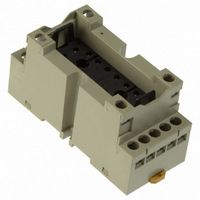P7S-14F Omron, P7S-14F Datasheet - Page 7

P7S-14F
Manufacturer Part Number
P7S-14F
Description
Contact OSTI
Manufacturer
Omron
Series
G7Sr
Type
Socketr
Specifications of P7S-14F
Number Of Positions
14
Mounting Type
DIN Rail
Termination Style
Screw Terminal
Socket Mounting
DIN Rail
Socket Terminals
Screw
Voltage Rating
24VDC
Rohs Compliant
Yes
Lead Free Status / RoHS Status
Lead free / RoHS Compliant
For Use With/related Products
G7S Series
For Use With
Z2362 - RELAY SAFETY 6A 24VDC PLUG-INZ2363 - RELAY SAFETY 6A 24VDC PLUG-IN
Lead Free Status / RoHS Status
Lead free / RoHS Compliant
Other names
P7S14F
Z2417
Z2417
Available stocks
Company
Part Number
Manufacturer
Quantity
Price
Company:
Part Number:
P7S-14F
Manufacturer:
Omron Electronics Inc-EMC Div
Quantity:
135
Precautions for All Relays
Refer to the Safety Precautions section for each Relay for specific precautions applicable to that Relay.
■ Precautions for Safe Use
These precautions are required to ensure safe operation.
• Do not touch the charged Relay terminal area or the charged
• Do not use a Relay for a load that exceeds the Relay's switching
• Do not drop or disassemble Relays. Doing so may reduce Relay
• Relay durability depends greatly on the switching conditions.
■ Precautions for Correct Use
Contents
A
B
C
No.
socket terminal area while the power is turned ON. Doing so may
result in electric shock.
capacity or other contact ratings. Doing so will reduce the specified
performance, causing insulation failure, contact welding, and
contact failure, and the Relay itself may be damaged or burnt.
characteristics and may result in damage, electric shock, or
burning.
Confirm operation under the actual conditions in which the Relay
will be used. Make sure the number of switching operations is
within the permissible range. If a Relay is used after performance
has deteriorated, it may result in insulation failure between circuits
and burning of the Relay itself.
Using Relays
Selecting
Relays
Circuit
Design
Area
http://www.ia.omron.com/
A
B
C
A
B
C
No. Classification No.
Mounting
Structure and
Type of
Protection
Drive Circuits
Loads
Load Circuits
Input Circuits
Mounting
Design
1
2
3
1
2
1
2
1
2
3
4
5
6
7
8
9
10
11
1
2
3
4
5
6
7
8
9
10
11
12
13
1
2
3
4
Type of Protection
Combining Relays and Sockets
Using Relays in Atmospheres Subject to Dust
Providing Power Continuously for Long Periods
Operation Checks for Inspection and Maintenance
Contact Ratings
Using Relays with a Microload
Load Switching
Electrical Durability
Failure Rates
Contact Protection Circuits
Countermeasures for Surge from External Circuits
Connecting Loads for Multi-pole Relays
Motor Forward/Reverse Switching
Power Supply Double Break with Multi-pole Relays
Short-circuiting Due to Arcing between NO and NC Contacts in SPDT Relays
Using SPST-NO/SPST-NC Contact Relays as an SPDT Relay
Connecting Loads of Differing Capacities
Maximum Allowable Voltage
Voltage Applied to Coils
Changes in Must-operate Voltage Due to Coil Temperature
Applied Voltage Waveform for Input Voltage
Preventing Surges when the Coil Is Turned OFF
Leakage Current to Relay Coils
Using with Infrequent Switching
Configuring Sequence Circuits
Connecting Relay Grounds
Individual Specifications for Must-operate/release Voltages and Operate/Release Times
Using DC-operated Relays, (1) Input Power Supply Ripple
Using DC-operated Relays, (2) Coil Polarity
Using DC-operated Relays, (3) Coil Voltage Insufficiency
Lead Wire Diameters
When Sockets are Used
Mounting Direction
When Devices Such as Microcomputers are in Proximity
A Resistive Loads and Inductive Loads
B Switching Voltage
C Switching Current
• Do not apply overvoltages or incorrect voltages to coils, or
• Do not use Relays where flammable gases or explosive gases may
• Perform wiring and soldering operations correctly and according to
incorrectly wire the terminals. Doing so may prevent the Relay from
functioning properly, may affect external circuits connected to the
Relay, and may cause the Relay itself to be damaged or burnt.
be present. Doing so may cause combustion or explosion due to
Relay heating or arcing during switching.
the instructions contained in Precautions for Correct Use given
below. If a Relay is used with faulty wiring or soldering, it may
cause burning due to abnormal heating when the power is turned
ON.
(c)Copyright OMRON Corporation 2007 All Rights Reserved.
Item
C-4
C-4
C-4
C-5
C-7
C-9
C-3
Page
C-2















